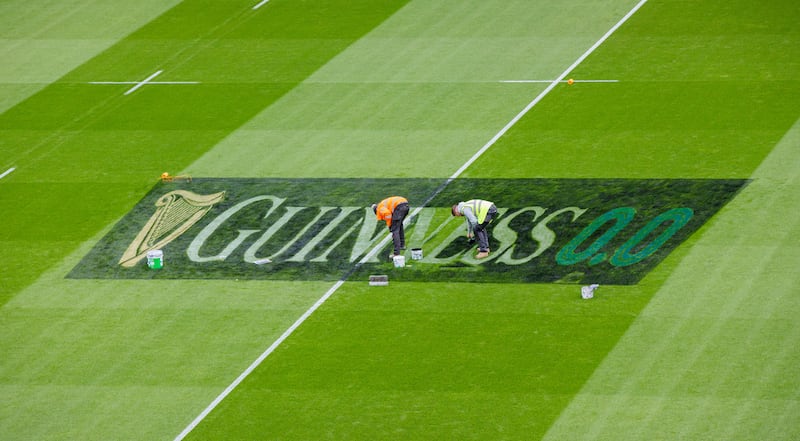Whatever about the Ireland fans in the crowd, James Lowe’s astonishing, hero-making try in the Six Nations game against France was a marketing department’s dream.
As he gripped the ball to plant it over the line his fingers splayed out across the Guinness 0.0 logo – upside down, but you can’t have everything – which was facing the TV cameras.
The pass could so easily have delivered the other side of the ball into Lowe’s hand and then Gilbert its maker would have felt the promotional bounce. So chance delivered this serendipitous bonus for the rugby tournament sponsor – although in reality, viewers will have been in little doubt of their name, not least because of the giant “Guinness” painted on the pitch and the branded padding on the goalposts and flag-topped corners.
There’s a lot of advertising real estate in rugby. And while the harp, the lettering and dark background – globally recognised for decades as belonging to the stout brewed at St James’s Gate – it was the two digits, 0 0, with the full stop in between that legally permitted the brand to be on the pitch at all.
Guinness is the title sponsor of the rugby tournament in a deal inked in 2019. In 2020 following four years of development Diageo launched Guinness 0.0, an alcohol-free version of its famous stout, into the fast-growing, consumer-driven market for non-alcoholic versions of existing drinks.
In late 2021, the long-awaited and much debated new legislation around sport and alcohol promotion came into force with Government guidelines reminding the drinks industry that “alcohol advertising on a sports area, eg a football pitch, is prohibited”. A fairly basic demand in a law developed as a way of breaking the link between alcohol and sport. It went on: “However the prohibition does not include the hoardings around the perimeter of the pitch.”
That’s why the hoardings around the pitch and elsewhere in the Aviva Stadium for the rugby internationals show Guinness – mostly name and harp only with no further product explanation needed for such an iconic brand – and the on-pitch advertising is for the company’s alcohol-free option which bears similar branding but with the addition of the 0.0.
In that Diageo is clearly fully compliant with the new legislation.
“We fully support the objective of reducing harmful use of alcohol, and activity in respect of the Guinness Six Nations complies with the legislation,” said a Guinness spokeswoman.
“From the very beginning, we have used this sponsorship to communicate the message of moderation that is core to our business.”
However, Alcohol Action Ireland, a lobby group that advocates for reducing alcohol harm, argues that such “brand sharing” – whereby the non-alcoholic version of a drink has branding similar to that of the alcoholic version, and the advertising that supports it, “makes a mockery of the law” in the words of the group’s chief executive Dr Sheila Gilheany.
When the new rules hit the statute books AAI was quick to point to examples from other jurisdictions of so-called “alibi marketing”, where core elements of a brand’s identity, such as a strapline, word, colour or shape, are used in advertising to circumvent laws.
In France, for example, it pointed out that when legislation was brought in to curb alcohol advertising in sports, the Heineken Cup became the “H Cup” with the brand’s familiar green colour and red star.
For its part Diageo says that the on-pitch promotion of Guinness 0.0 in Dublin is consistent with its promotional push for its new brand which offers consumers a non-alcoholic option and that the Guinness 0.0 logo also appears on and off the pitch in England, Scotland and Wales for the rugby tournament.

Since last April viewers of Coronation Street and Emmerdale will have spotted a new tap behind the bar in the Rovers Return and The Woolpack. ITV struck a deal with Heineken to feature its Heineken 0.0 product on draught – the branded tap sits alongside fictional alcoholic brands Newton & Ridley and Ephraim Monk.
Ofcom, the UK broadcasting regulator, bans paid-for alcohol product placement in such programmes, so standard Heineken would not be allowed, but the alcohol-free version is.
At the time of the deal the drinks brand said the availability of 0.0 in the soap operas’ pubs helps normalise the idea of people ordering a non-alcoholic option.
And indeed there’s a strong consumer behaviour argument to be made that by designing the branding, bottles, label, etc, for their non-alcoholic beers in a way that closely mimics the “regular” version, brands such as Heinekin have helped people, in a society that can judge non-drinkers, have the confidence to order them. And by putting significant marketing spend behind the zero alcohol options, consumers really do have a choice.

Irish jewellery designer Chupi: 'The divorce ring is a whole new category'
Critics of the deal, however, have pointed out that soap operas have a family audience and while the 0.0 is clearly in evidence have questioned whether viewers are likely to immediately think of alcohol when they see familiar Heineken imagery and not take in the 0.0 element.
The power of two digits – 0.0 – to bring well-known alcohol brand names into places they might otherwise not be is likely to mystify drinkers in Norway where the legislation around alcohol advertising and promotion is far reaching.
Non-alcoholic beverages must have their own distinct branding, quite different from the parent brand. And such is the extensive reach of the legislation – that goes far beyond playing pitches into social media – that a bar got into trouble at Christmas by posting on social media a message that included a cocktail emoji, the umbrella in the drink was judged to have indicated an alcoholic drink and therefore the code was breached.






